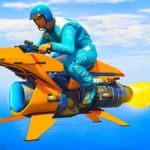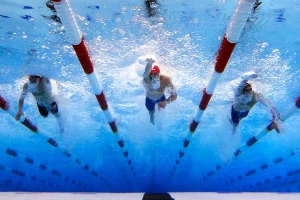The art of riding a horse is known as equestrian or horseback riding. Dressage, show jumping, and eventing are the current Olympic horse competitions. The International Federation for Equestrian Sports also recognises combination driving, endurance, reining, and vaulting as additional events. Continue reading to discover more about the equestrian sport.
Equestrian History
The origins of contemporary equestrian sports can be found in ancient Greece when dressage was created as a means of preparing horses for combat. The Athenian general Xenophon noticed that horses might be exploited as a great strategic advantage over forces on foot if they were allowed to travel freely in a herd and used their natural motions as a guide. As non-military people started participating in the sport, modern dressage evolved while keeping many of the fundamental ideas.
When chariot racing was added to the Olympic Games in antiquity, horses were also employed in those events. The steeplechase and fox hunt of the 17th and 18th centuries gave rise to jumping. In the 1500s, foxhunting was first practised in England as a means of managing vermin populations. It became essential to develop horses that could leap over barriers and travel great distances with ease when farmers started fencing off their land. Eventing began as a means of training and testing military horses in cross-country, show jumping, and dressage.
The history and customs of hunting in England are also the foundation for many of the stylistic elements of equestrian athletics. The manes and tails of horses were braided to prevent matting or snagging. Hunting techniques are also the source of riding coats, breeches, leather boots, and other apparel items commonly used during horse contests.
Equestrian playing surface
A lot of horse sports competitions are held in arenas. The climate determines whether these arenas are indoor or outdoor. Equestrian surfaces, usually referred to as footings, have been produced scientifically and can be high-tech in response to the needs of riders.
Although they can be used as footings, wood chips and rubber pieces often perform worse. Sand-based footing is the most common type. Whereas uncoated surfaces glue the sand particles together with water, coated sand-based footings use a coating to hold the components of the footing together.
Equipment needed in Equestrian
Equestrian sports require a lot of equipment for both the horse and the rider. Important training equipment for the rider includes:
- Breeches and Tights
- Shirts and tops
- Tall boots
- Riding helmets
- Show apparel
- Casual footwear
- Gloves
- Outerwear
- Paddock boots
- Half chaps or full chaps
- Socks
Show apparel includes:
- Show shirt
- Competition jacket
- Show breeches
- Sock tie
- Hair nets
Different events in Equestrian
Dressage, show jumping, and eventing are the three horse sports that are contested in at the Olympics. The International Federation for Equestrian Sports (FEI), which oversees equestrian competition, additionally acknowledges combined driving, endurance, and vaulting.
Dressage
In dressage, a rider’s ultimate score is determined by combining their evaluation of the horse’s suppleness and elasticity with the calibre of their training. Each rider completes a test consisting of a freestyle routine and 33 specified motions. With a regular score in the 70s and an extraordinary score in the 80s, each move is graded from zero to ten and combined for a final score of 100.
Show Jumping
In show jumping, horses and riders must clear obstacles in predetermined courses in a given amount of time with little to no error. Jumpers have to be careful not to knock down obstacle poles or cause the horse or rider to tumble.
Eventing
Dressage, show jumping, and endurance, or cross-country, are all combined in eventing. A number of obstacles over a variety of terrain must be overcome by the rider and horse during the endurance or cross-country section of the event, which takes place over two or three days. In this discipline, men and women compete against one another. As racers rack up penalty points during the tournament, the rider with the fewest points wins.
Combined Driving
A three-phase carriage driving discipline is combined driving. One, two, or a four-horse team may be employed.
Here are the phases of combined driving in equestrian:
- Driven Dressage: Evaluates the driver and horse’s harmony.
- Marathon: Tests the precision, judgement, and fitness of the drivers and the horses across obstacles.
- Cones: With carriage wheels, drivers must manoeuvre a narrow route without running over cones.
Endurance
Horses competing in endurance races travel great distances. The shortest authorised distance is 25 miles, which can be finished in six hours, 50 miles in twelve hours, and 100 miles in twenty-four hours.
Reigning
The Western dressage is another name for the riding discipline known as reigning. Horses are led through predetermined sequences of circles, spins, and stops to demonstrate their athletic prowess and fit for a ranch. From 2000 until 2021, reigning was one of the six FEI-sanctioned disciplines; however, as of right now, it is not.
Vaulting
Gymnastics and dancing techniques are combined in equestrian vaulting, where they are applied on a moving horse. On moving horses, riders execute gymnastic and acrobatic routines, including jumps.
Ring Etiquette
Within the realm of equestrian sports, there are customary regulations, procedures, and social graces. Among the guidelines and customs of customary ring etiquette for riders are:
- Make sure that your horse’s left shoulder and the horses’ left shoulders are on the same side whenever you pass them in the warm-up arena by constantly going “left shoulder to left shoulder.”
- When a horse has a red ribbon around its tail, it indicates that it kicks, therefore approach them with caution.
- Declare loudly when you are entering and leaving the arena.
- Maintain a minimum of one horse’s distance between you and another equine.
Judges
In addition to selecting the victors of the competition, judges also make sure that the horses are kept safe and fairly treated. For instance, before horses even enter the arena for show jumping and dressage competitions, judges make sure they are healthy enough to compete. Every competition discipline is evaluated in a unique way.
Dressage judges are more likely to be subjective in their evaluations as they observe minute movements between the horse and rider, whereas show jumping judges evaluate jumps objectively based on clearing them. Prior to the tournament, judges for each discipline make sure that the arena is in an equitable state. Judges of show jumping collaborate with designers of the courses to ensure that the difficulty level of the courses is suitable.
Lingo and Terminology
Here are some terms to know in the sport of equestrian:
- Chef d’Equipe: Head trainer or manager of a nation’s national horse squad.
- Balk: When a horse refuses to move or comply with the rider’s requests.
- Tack: Equine riding and training equipment.
- Offside: The horse’s right side.
- Nearside: The horse’s left side.
- Canter: Horses move in three beats, ranging in speed from a trot to a gallop.
- Hand: The height of a horse expressed in this unit. Roughly four inches, or ten centimetres.
- Posting: In order to improve comfort and smooth out the ride, posting is the action of the horse’s front legs rising in and out of the saddle every other stride.
Skills and Techniques
For equestrian sports, self-awareness, focus, steady hands, patience, and consistency are some essential core abilities. Riding a horse can be risky, so it’s critical to have strong foundational abilities. Even though they are not technical riding skills, these abilities will help the rider gain a deeper comprehension of their horse and enable them to function as a productive team. It’s critical to establish positive habits since even the smallest movements can have an impact on how your horse relates to you. The ability to mount and dismount, balance, turn, reverse, back up, space out an arena, sit, post, and canter are additional essential skills.
Coaching
An athlete participating in equestrian sports typically practices in an arena under the guidance of an instructor. They support the rider in developing and honing their skill set on the horse as well as helping to correct any bad habits and mistakes. Many European nations require instructors to be certified, however, US and Canadian instructors are exempt.
Certification has several advantages, such as increased safety, the ability to work for a higher salary, and the ability to be employed as an instructor at a better stable or farm, even if it is not necessary in the US and Canada. For each session, an instructor’s fee might vary from $45 to $80 per hour; after earning certification, they can charge more.
- American Riding Instructors Association (ARIA): Certifies teachers in more than fifteen fields.
- Certified Horsemanship Association (CHA): Qualifications in driving, horse facility management, trail riding, vaulting, English and Western riding, driving instruction, and teaching disabled riders.
- Centered Riding: Provides four certification levels.
- Professional Association of Therapeutic Horsemanship International (PATH): Provides certification for instructors of therapeutic riding who work with riders who have unique needs.
- US Dressage Federation: Offers dressage certification.
- US Hunter Jumper Association: Provides hunting seat riding certification.
- British Horse Society: A highly regarded certification programme in Great Britain for educators.
Some well-known equestrian coaches and chefs d’equipes are:
- Meghan Boenig: Head coach of the University of Georgia’s varsity women’s equestrian team. Has six national championships in varsity equestrian competition.
- Debbie McDonald: US Technical Advisor/Chef d’Equipe for Dressage.
- Erik Duvander: US Eventing Chef de Partie/Technical Consultant. worked in the past with the New Zealand, Swedish, and Japanese equestrian teams.
- Robert Ridland: Chief Technical Advisor/Equipment Show Jumping in the U.S.
- Monica Therdescu: Head coach of the German dressage team.
Drills
A rider’s body has an impact on the horse they are riding, and equestrian sports can be physically taxing. It’s critical to teach your body to stop communicating to the horse incoherently through your hands, legs, and seat. To counteract overly forceful hands, which may cause the horse to become overly forceful, grasp the reins in reverse, akin to a driving horse’s reins. Changing the posting sequence to sit in the saddle for two beats, rise up for one, then alternate between staying out of the saddle for two beats and sitting for one is a drill that can aid with leg posture and balance.
Olympic Equestrian
Although they were originally scheduled for the 1900 Paris Games, equestrian jumping sports were dropped until the Stockholm Games of 1912. Equestrian competitions have been a part of the Olympic schedule since 1912. Up until 1948, men were the only competitors allowed to compete in Olympic equestrian events since riders had to be military officers. After the officer limitation was removed in 1951, women began competing in the summer games in Helsinki in 1952, first in dressage and then in show jumping and eventing.
Eventing is one of the few Olympic sports in which men and women participate side by side on an equal basis. There are individual and team competitions in each of the three events. A maximum of three riders per country are permitted for each individual event. Ian Millar of Canada became the oldest medallist of the 2008 Summer Games when he won the silver medal in team jumping at the 2008 Beijing Summer Games. Millar was 61 years old.
Equestrians
Equestrians are generally defined as horseback riders and participants in equestrian activities. The following are a few of the greatest riders in history:
- Adolph van der Voort van Zijp (Netherlands): Dutch show jumper who competed internationally and represented the country on horseback.
- Andrew Hoy (Australia): Legendary Australian eventer; multiple winners of elite competitions including Burghley and badminton; Olympic gold medallist.
- Anky van Grunsven (Netherlands): Dutch dressage legend, famous for her collaboration with the horse Salinero, is a multiple Olympic gold medallist and world champion.
- Charles Pahud de Mortanges (Netherlands): Dutch event rider who won two gold medals in the 1930s Olympics.
- Charlotte Dujardin (Great Britain): Dressage sensation from Britain; double Olympic gold medallist, world champion, and record-setter in the sport.
- Hans Günter Winkler (Germany): Legendary German show jumper and Olympic gold medallist, he is well-known for his amazing feats, which include his famous ride on Halla.
- Henri Saint Cyr (Sweden): Swedish equestrian of note in dressage; competed internationally and represented Sweden in several Olympic Games.
- Isabell Werth (Germany): The most decorated equestrian Olympian, with numerous gold medals and global titles, is a German dressage superstar.
- Ludger Beerbaum (Germany): Master of show jumping from Germany; gold medallist at the Olympics and multiple winners of major international Grand Prix competitions.
- Matthew Ryan (Australia): Australian eventing great, known for his accomplishments in the sport and having competed for Australia in several Olympic Games.
- Nicole Uphoff (Germany): German dressage champion, multiple world champion, Olympic gold medallist, and well-known for her relationship with Rembrandt the horse.
- Reiner Klimke (Germany): Legendary German dressage and event rider; multiple champion and award winner during his career; Olympic gold medallist.
- Richard Meade (Great Britain): An iconic figure in British eventing, he is a double Olympic gold medallist, a European champion, and well-known for his superb riding and accomplishments in the sport.
Conclusion
In conclusion, the rich tapestry of equestrian sports weaves together a history deeply rooted in ancient practices and continues to thrive through modern innovations. From its origins in ancient Greece, where dressage was born out of the need for strategic military advantage, to the evolution of various disciplines such as show jumping and eventing, equestrianism has stood the test of time as a testament to the bond between human and horse.
As we delve into the intricate history of equestrian sports, it becomes evident that its development has been influenced by a myriad of factors, including cultural traditions and societal needs. The evolution of foxhunting in England, for instance, not only shaped the landscape of horse contests but also gave rise to many stylistic elements still prevalent today. Additionally, the diverse range of events recognized by the International Federation for Equestrian Sports showcases the versatility and adaptability of this sport to meet the evolving demands of contemporary society.
Furthermore, the art of equestrianism transcends mere competition; it encompasses a rich tapestry of customs, etiquette, and skills. From the customary ring etiquette that governs interactions between riders to the essential core abilities required for successful horsemanship, equestrianism fosters a profound connection between rider and horse. As we celebrate the achievements of legendary equestrians throughout history and marvel at their unparalleled skill and dedication, it is evident that equestrian sports will continue to captivate audiences and inspire generations to come.




























